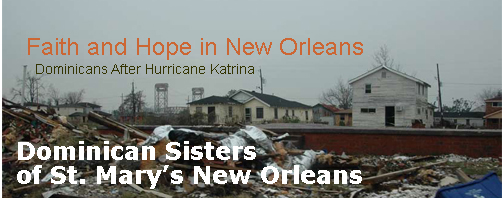
St. Mary’s Dominican
High School: A Wave of Success
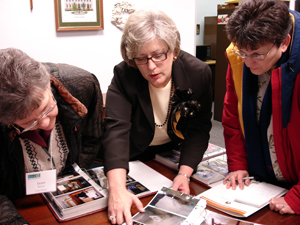 |
Cindy
Thomas, (center) President of St. Mary Dominican
High School, shares pictures of the school and the
recovery effort with Janet Brown, OP, and Beth Murphy,
OP |
After Hurricane Katrina took New Orleans by storm on August
29, 2005, a tsunami of organizational skills rose up from
the ranks of St. Mary’s Dominican High School administrators,
teachers, staff, and alumnae. This visionary storm created
an unprecedented wave of successful rehabilitation at the
school.
Two years after Katrina, except for the stackless
library or the lack of shelving in the band and art rooms,
visitors who were unaware might not realize the school
sustained $4.5 million in damages after the category five
hurricane, when levies holding back Lake Ponchetrain were
breeched flooding much of the city, including the St. Mary’s
New Orleans Dominican-sponsored school on Walmsley Street
in the city’s Carrollton district.
The day after the storm a school parent reached its president,
Cynthia Thomas in Atlanta, where she evacuated to before
the storm. “‘Do not be overwhelmed,’” she
recalls him saying to her. “‘You will have
a lot to face and we are going to be with you.’”
About 18 inches of water filled the school, minimal in
a city that had significant portions under 10 feet or more
of fetid, toxic sludge. But it was early October before
administrators were let back into the school. By that time,
mold had colonized the once proudly immaculate building,
so that nearly all of the schools’ contents were
lost.
By September 2006, barely 13 months after Katrina hit,
the school community dedicated Siena Center, a brand new,
collegiate-level athletic facility that sports a state-of-the-art
dance studio and training facility. Prior to the storm,
Thomas said, she was frustrated with the construction project
because it was falling behind schedule. What should have
been an enclosed building by August 2005 was at that time
only a concrete and steel frame.
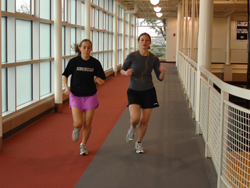 |
Students
use the school athletic track |
“Thank God we were late with construction” Thomas
says, as she fumbles with a ring of keys to grant her guests
entrance to the new facility.
The delayed construction project brought another hidden
blessing to the school. The Siena Center contractor quickly
switched projects, transferring to recovery efforts and
securing the services of a professional recovery service.
The school reopened on January 17, 2006, less than five
months after the disaster.
Thomas acknowledges that it was the professionalism of
the school’s administrators, teachers and staff,
and the dedication of Dominican families, alumnae, and
other supporters that made such rapid recovery from crisis
possible.
Key to the success, she suggests, were the six organizational
principles that guided her team through the recovery process: “Prayer,
people, program, policy, property, and preaching,” Thomas
enumerates. “And always people first.”
Thomas worked long distance with her administrative team
and the school’s board of directors to coordinate
recovery efforts. Her priorities were to make contact with
school families, ascertain the level of damage to the school,
and craft a plan for recovery.
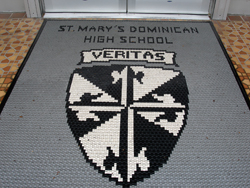 Within three weeks of Katrina nearly all of the 1,065
Dominican students were located by school staff, and the
process of visiting the school families in their evacuation
locations began. Thomas and the other administrators want
to be sure the school families saw a face from Dominican
in their time of need. Within three weeks of Katrina nearly all of the 1,065
Dominican students were located by school staff, and the
process of visiting the school families in their evacuation
locations began. Thomas and the other administrators want
to be sure the school families saw a face from Dominican
in their time of need.
Weekly board of director’s meetings via teleconference
began the recovery process. It was at one such meeting
that the board made the daring decision to continue paying
salaries for all of their employees while simultaneously
either refunding or deferring tuition for school families. “It
made no sense,” Thomas acknowledges, yet she and
the board were convinced it was the right thing to do. “We’ve
been blessed by that decision,” she adds. A year
and a halfafter the tragedy, by January of 2007, school
enrollment stood at 87% of pre-Katrina levels, most of
the faculty and staff returned, and the esprit d’ corps
couldn’t
have beenhigher.
The generosity of other supporters has been a major factor
in the school recovery process. Grants came from such sources
as the Laura Bush Foundation, Ford Motor Credit, and the
pop singer Josh Groban. A development consultant who had
previously worked with the school offered the services
of his firm, pro bono. With his help, within three weeks
of the storm and before most other institutions had been
able to assess their damages, Dominican had an emergency
appeal letter in the mailboxes of their alumnae, who responded
generously.
Dominican also benefited from the generosity of other
Dominican high schools and communities around the U.S.
About 180 students from St. Mary’s Dominican transferred
to two schools in Houston run by the Houston Dominican
Sisters, St. Agnes and St. Pius X. No one was turned away
for lack of ability to pay and the students were provided
with uniforms and free meals for the duration of their
stay.
The technology staff at St. Pius was crucial to successful
student location efforts. They hastily built and hosted
a website that became the centerpiece of the efforts to
contact the Dominican High School diaspora. Students at
Rosary High School in Aurora, Ill., raised more than $10,000
to replace the books in the library, everyone of which
was destroyed by mold. Other Dominican congregations also
reached out, supporting the students and faculty with prayer,
fundraising efforts, or pro bono grant-writing.
In her own reflection on her experience of Katrina and
its aftermath, Thomas says she feels like the Dominican
High School community is doing their best to preach the
message of paschal mystery by their response to the crisis,
immediate and on-going.
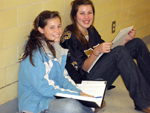 Perhaps the greatest challenges the school faced as a
result of Katrina are behind them, but by no means is the
struggle over. Enrollment is in good shape but is not yet
at pre-Katrina levels. It may be a challenge to keep
teachers as families are faced with making other choices
based on economic necessity, energy bills are three times
the level they were in the fall of 2005, and it is still
an open question whether the city will be able to work
its way back to life. Perhaps the greatest challenges the school faced as a
result of Katrina are behind them, but by no means is the
struggle over. Enrollment is in good shape but is not yet
at pre-Katrina levels. It may be a challenge to keep
teachers as families are faced with making other choices
based on economic necessity, energy bills are three times
the level they were in the fall of 2005, and it is still
an open question whether the city will be able to work
its way back to life.
One of Thomas’s ongoing frustrations is that “the
system is not working” on behalf of the well-being
of the city of New Orleans. She can point to the reality
of the school community and see that. Thirty-four of her
teachers lost their homes in Katrina and some of them are
still living in FEMA trailers. She says she doesn’t
have all the answers, that she and the school staff are
still finding the way through the post-Katrina reality,
but she is sure about one thing. “I am doubly committed
to Catholic education,” she says emphatically. “We
need people with the power and the morals to make a difference
and change systems.”
Story Contributors: Beth Murphy, OP (Springfield),
Janet Brown, OP (Grand Rapids), JoAnn Niehaus, OP (Houston),
Joan Smith, OP (Sparkill) |
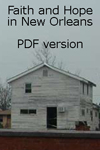
 Can't
open PDF format files? Click on the link to download the latest Adobe
Reader. It is safe and secure and free. Really.
Can't
open PDF format files? Click on the link to download the latest Adobe
Reader. It is safe and secure and free. Really.




 Within three weeks of Katrina nearly all of the 1,065
Dominican students were located by school staff, and the
process of visiting the school families in their evacuation
locations began. Thomas and the other administrators want
to be sure the school families saw a face from Dominican
in their time of need.
Within three weeks of Katrina nearly all of the 1,065
Dominican students were located by school staff, and the
process of visiting the school families in their evacuation
locations began. Thomas and the other administrators want
to be sure the school families saw a face from Dominican
in their time of need. Perhaps the greatest challenges the school faced as a
result of Katrina are behind them, but by no means is the
struggle over. Enrollment is in good shape but is not yet
at pre-Katrina levels. It may be a challenge to keep
teachers as families are faced with making other choices
based on economic necessity, energy bills are three times
the level they were in the fall of 2005, and it is still
an open question whether the city will be able to work
its way back to life.
Perhaps the greatest challenges the school faced as a
result of Katrina are behind them, but by no means is the
struggle over. Enrollment is in good shape but is not yet
at pre-Katrina levels. It may be a challenge to keep
teachers as families are faced with making other choices
based on economic necessity, energy bills are three times
the level they were in the fall of 2005, and it is still
an open question whether the city will be able to work
its way back to life. 